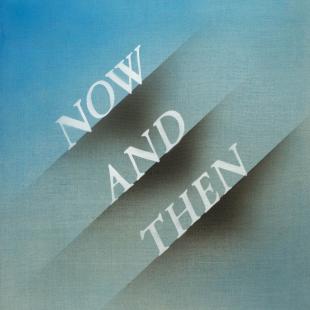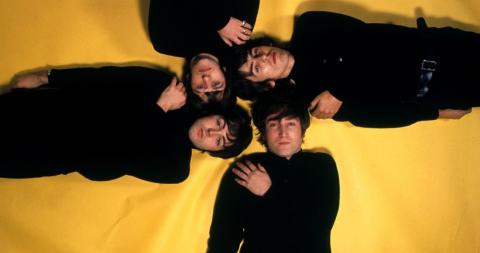


The Beatles are regarded as the biggest, best and most influential musical act to ever emerge from Britain, if not pop music itself.
In a relatively short career together - with the band forming in 1960 before splintering for good ten years later in 1970, and just eight years after their debut chart hit Love Me Do in 1962 - John Lennon, Paul McCartney, George Harrison and Ringo Starr pumped out music (and, in the earlier part of their career, very quickly, issuing 6 LPs in the space of two years between 1963 and 1965) that influenced and changed the entire culture of popular music.
With 18 UK Number 1 singles to their name, The Beatles are the British act with the most Number 1 singles in history, only Elvis Presley has more Number 1s with 21 in total).
Here, we detail each of The Beatles's 18 Number 1 hits on the UK's Official Singles Chart - from their very first Number 1 in 1963 - From Me To You, in 1963 to their last, Now and Then, in 2023.
In extraordinary circumstances befitting an extraordinary band, The Beatles earned their 18th UK Number 1 single with their 'last' official release, Now And Then, a whole 54 years since their last chart topper (The Ballad of John and Yoko, 1969).
Read more on the incredible record-breaking Number 1 that is The Beatles’ Now and Then.
Only the third single ever released by the Fab Four, From Me To You was the one that started their chart domination; becoming the first Beatles song to top the Official Singles Chart in May 1963 where it stayed at Number 1 for seven consecutive weeks. Revisit the chart for the week when The Beatles scored their first Number 1.
The Beatles didn't have to wait long for their second chart-topper, grabbing it just four months after From Me To You in September 1963.
She Loves You holds a special place in The Beatles canon, it is officially the best-selling single from the 1960s, and the best-selling single from the group in the UK too.
Often overlooked, too, is that in the "yeah yeah yeah" refrain, the songwriting team of Lennon-McCartney perfected one of the most enduring pop hooks ever.
I Want To Hold Your Hand was originally blocked from Number 1 by She Loves You, but once it did get all the way to the top of the Official Singles Chart, it stayed there for five weeks and became the second best-selling song of the 1960s.
The Beatles were the first act in history to score a hat-trick of Christmas Number 1 victories, paving the way for Spice Girls and LadBaby to equal their feat many decades later. I Want To Hold Your Hand was the first of The Beatles' trio of festive chart toppers, securing the coveted Christmas Number 1 in December 1963, before following it up with a second in 1964 with I Feel Fine, then landing their third and final Christmas Number 1 in 1965 with Day Tripper / We Can Work It Out. Revisit the list of every Christmas Number 1 ever.
I Want To Hold Your Hand also holds the distinction of being the Beatles's breakthrough single in the US. Their performance of the track on The Ed Sullivan Show that year is now regarded by many to be the start of Beatlemania, and one of the most important milestones in the journey of pop music.
Can't Buy Me Love was taken from The Beatles' third studio album, A Hard Day's Night, a body of work that started a new phase in the band's career, as every single track on the record was written by John Lennon and Paul McCartney, under the moniker Lennon-McCartney, now looked on as perhaps the greatest songwriting partnership in the history of recorded music. Can't Buy Me Love went on to become the third best-selling song of the 1960s here in the UK.
Opening with an iconic riff from George Harrison, A Hard Day's Night (taken from the soundtrack of the film of the same name), was apparently written by John Lennon in one night, although you can hear Paul McCartney performing the song's bridge since Lennon couldn't reach the notes. A Hard Day's Night toppled The Rolling Stones' It's All Over Now to claim the Number 1 spot in July 1964.
I Feel Fine, the second of The Beatles' three consecutive Christmas Number 1 hits, was composed entirely by John Lennon, with the guitar riff being composed as the group recorded Eight Days A Week, but still retained the Lennon-McCartney credit, as became standard throughout the group's tenure.
I Feel Fine is also one of the earliest examples of the use of feedback during recording, instead of just during live performances. In one of the last interviews he gave before his death, Lennon said: "I defy anybody to find a record – unless it's some old blues record in 1922 – that uses feedback [like I Feel Fine]."
One of the first examples of the Beatles searching for a harder sound, two years out from their debut, Ticket to Ride was the first Fab Four track to feature Paul McCartney on lead guitar. Also the first Beatles song to come in at over 3 minutes long, Ticket To Ride became the band's seventh consecutive Number 1 hit in the UK, and their third consecutive chart-topper in the US.
Written by Lennon as, wouldn't you know it, a cry for help after The Beatles's sudden and life-changing spiral into world-conquering superstardom.
Looking back on this time, Lennon would say in the '70s that he considered Help! and Strawberry Fields Forever to be his most 'honest' compositions for the Beatles, and Help! is looked on now as the first crack in his protective armour around his feelings as The Beatles quickly became the biggest band in the world.
A double A-side single that went all the way to Number 1, We Can Work It Out specifically is one of the last instances in the Lennon-McCartney partnership where both artists worked on a song in tandem (in later Beatles works, songs would be majorly composed by one or the other, but still retain the shared credit).
Composed thanks to Paul McCartney's Aunt Lil, who challenged him to write a song that wasn't about love, Paperback Writer was one of the first song's written in the sessions for the incendiary Revolver record, and was the last new song to feature on the setlist for The Beatles' last tour as a group in 1966.
Another double A-side single that went all the way to Number 1, the two songs included (Yellow Submarine and Eleanor Rigby) couldn't be more different.
One (Yellow Submarine) is a saccharine children's song composed by McCartney and the other (Eleanor Rigby), with its famous double string quartet arrangement from George Martin, is a flag in the ground for The Beatles as the '60s entered their dying years, turning them away from pop idols and into more experimental, psychedelic rock innovators. Revisit the chart from the week Yellow Submarine / Eleanor Rigby landed at Number 1.
A defining song for the Flower Power counter-culture movement that emerged at the time, All You Need Is Love remains synonymous with the 1967 Summer of Love, where as many as 100,000 young people identifying as hippies converged in an area of San Francisco in a heady meeting of utopian ideals.
The first single released by the band following the death of their manager Brian Epstein, Hello, Goodbye featured on The Magical Mystery Tour. The song was at the centre of a scuffle for the band, Lennon was hell-bent on the more trippy I Am The Walrus being issued as a single, but relented given Hello, Goodbye's more commercial nature. I Am The Walrus served as the B-side for the single release.
Lady Madonna marked a return to a more conventional approach to song style and structure for The Beatles, following their most experimental period. Lady Madonna was also the last record in the UK released by The Beatles long-time label Parlophone, subsequent releases would come from their own record label, Apple, via a deal with EMI. Revisit the chart the week Lady Madonna claimed Number 1.
If not the most popular, then perhaps the most easily recognisable Beatles single, Hey Jude was written by McCartney to console Lennon's youngest son, Julian, after his father had left his mother, his wife Cynthia, for Yoko Ono, a period of heavy uncertainty and upheaval in The Beatles' working relationships too.
Hey Jude was the first single released by The Beatles on their own record label, Apple, and toppled The Bee Gees' classic I Gotta Get A Message To You from the summit. Hey Jude remains one of their most enduring and much-loved compositions, selling in excess of 1 million copies in the UK.
The first and only time The Beatles topped the Official Singles Chart with a collaborator (this being US keyboardist and singer Billy Preston), Get Back was the closing track of the Beatles' last studio album, Let It Be, which was released just after the band had split up for good.
The 17th and what everybody thought would be the final UK Number 1 single by The Beatles, The Ballad of John and Yoko was the full stop of an incredible career, that changed and shaped pop and rock in The Beatles' relatively short life.
Lennon and McCartney recorded the song - which chronicles the wedding of Lennon and Yoko Ono - without George Harrison and Ringo Starr and one of the last time that the two friends would collaborate in the studio together.
A bittersweet coda to the most enduring partnership in all of pop.
The record-breaking 18th UK Number 1 single by The Beatles, the fact that Now And Then even exists – let alone that it topped the Official Singles Chart – is a miracle.
Rescued from an abandoned John Lennon demo in the 70s and partially reconstructed by the remaining members in the 90s, Now And Then came to life thanks in part to AI technology and a celebration of The Beatles’ all-encompassing legacy.
As it reached Number 1, it helped The Beatles extend their lead as the British act with the most Number 1 singles in UK chart history, as well as the longest-gap between Number 1 singles (54 years) and the longest span of Number 1 singles (60 years from their first to their last). Read more about Now and Then's record-breaking moment here.
Image: Apple Corps


Join the conversation by joining the Official Charts community and dropping comment.
Already registered?
Log in
No account?
Register
guynewmountain
What about "Free As A Bird" of course! (?)
Number 1 in 1995!
Pah...
Bengy
And MMT EP was number one in both the Melody Maker and DISC magazines on 13th January 1968.
johnauld
For those around in 1963, we know that Please Please Me was number one only to be retrospectively knocked back to number two in 1969 . Also worth noting Magical Mystery Tour EP held of number one by Hello Goodbye.
neilrichardson
Yes, everyone knows Please Please Me was number 1 and it's about time it was reinstated. The 'Chart' now used by 'The Official Charts Company' was not even published at the time.
martin1
Yes I remember Neil & I agree is should be reinstated! :-)
martin1
Good times back then John. :-)